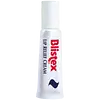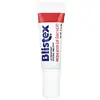What's inside
What's inside
 Key Ingredients
Key Ingredients

 Benefits
Benefits

 Concerns
Concerns

 Ingredients Side-by-side
Ingredients Side-by-side

Water
Skin ConditioningSimmondsia Chinensis Seed Oil
EmollientPolyglyceryl-3 Diisostearate
EmulsifyingCera Alba
EmollientSorbitan Isostearate
EmulsifyingLanolin
EmollientEthylhexyl Salicylate
UV AbsorberButyrospermum Parkii Butter
Skin ConditioningGlycerin
HumectantVitis Vinifera Seed Oil
EmollientAlcohol Denat.
AntimicrobialPEG-6 Almond Glycerides
EmollientStearyl Behenate
EmollientHydrogenated Soy Polyglycerides
Skin ConditioningMentha Piperita Oil
MaskingAroma
Allantoin
Skin ConditioningCamphor
MaskingDimethicone
EmollientOlea Europaea Fruit Oil
MaskingAmmonium Hydroxide
BufferingArachidyl Alcohol
EmollientArachidyl Glucoside
EmulsifyingBehenyl Alcohol
EmollientC15-23 Alkane
SolventCalcium Disodium EDTA
Hydrated Silica
AbrasiveLanolin Alcohol
EmollientLimonene
PerfumingLinalool
PerfumingPhosphoric Acid
BufferingSodium Hydroxide
BufferingSodium Saccharin
MaskingSucralose
Skin ConditioningThymol
AntimicrobialWater, Simmondsia Chinensis Seed Oil, Polyglyceryl-3 Diisostearate, Cera Alba, Sorbitan Isostearate, Lanolin, Ethylhexyl Salicylate, Butyrospermum Parkii Butter, Glycerin, Vitis Vinifera Seed Oil, Alcohol Denat., PEG-6 Almond Glycerides, Stearyl Behenate, Hydrogenated Soy Polyglycerides, Mentha Piperita Oil, Aroma, Allantoin, Camphor, Dimethicone, Olea Europaea Fruit Oil, Ammonium Hydroxide, Arachidyl Alcohol, Arachidyl Glucoside, Behenyl Alcohol, C15-23 Alkane, Calcium Disodium EDTA, Hydrated Silica, Lanolin Alcohol, Limonene, Linalool, Phosphoric Acid, Sodium Hydroxide, Sodium Saccharin, Sucralose, Thymol
Camphor 0.5%
MaskingDimethicone 1.1%
EmollientMenthol 0.625%
MaskingPhenol 0.5%
AntimicrobialAllantoin
Skin ConditioningAmmonium Hydroxide
BufferingBeeswax
Emulsion StabilisingCalcium Disodium EDTA
Calcium Hydroxide
BufferingCetyl Alcohol
EmollientAroma
Glycerin
HumectantHydrated Silica
AbrasiveLanolin
EmollientLauric Acid
CleansingParaffinum Liquidum
EmollientMyristic Acid
CleansingOleic Acid
EmollientPalmitic Acid
EmollientParaffin
PerfumingPetrolatum
EmollientPolyglyceryl-3 Diisostearate
EmulsifyingPotassium Hydroxide
BufferingWater
Skin ConditioningSd Alcohol 36
AstringentSodium Hydroxide
BufferingSodium Saccharin
MaskingStearyl Alcohol
EmollientCamphor 0.5%, Dimethicone 1.1%, Menthol 0.625%, Phenol 0.5%, Allantoin, Ammonium Hydroxide, Beeswax, Calcium Disodium EDTA, Calcium Hydroxide, Cetyl Alcohol, Aroma, Glycerin, Hydrated Silica, Lanolin, Lauric Acid, Paraffinum Liquidum, Myristic Acid, Oleic Acid, Palmitic Acid, Paraffin, Petrolatum, Polyglyceryl-3 Diisostearate, Potassium Hydroxide, Water, Sd Alcohol 36, Sodium Hydroxide, Sodium Saccharin, Stearyl Alcohol
Alternatives
Ingredients Explained
These ingredients are found in both products.
Ingredients higher up in an ingredient list are typically present in a larger amount.
Allantoin is a soothing ingredient known for its protective and moisturizingg properties. Because of this, it is often added to products with strong active ingredients.
Studies show higher concentrations of this ingredient can promote wound healing.
Though it can be derived from the comfrey plant, allantoin is produced synthetically for cosmetic products to ensure purity.
Learn more about AllantoinWe don't have a description for Ammonium Hydroxide yet.
Aroma refers to an ingredient, or mixture of ingredients, that impart or mask a flavor.
The name is slightly confusing. This is because INCI associates aroma with flavor instead of smell.
Here is the official definition from the The International Cosmetic Ingredient Dictionary and Handbook:
“Aroma is a term for ingredient labeling used to identify that a product contains a material or combination of materials normally added to a cosmetic to produce or to mask a particular flavor.”
INCI shows the only purpose of aroma to be "flavouring".
However, due to regulation differences, some companies may use aroma in place of parfum.
In Canada, this ingredient only has to be listed in concentrations above 1%.
Learn more about AromaWe don't have a description for Calcium Disodium EDTA yet.
Camphor is a waxy solid with a strong scent. It is made using turpentine oil.
This ingredient is used for medicinal purposes due to its cooling effect. In medicine, camphor is a common anti-inflammation ingredient.
Camphor also possesses antibacterial and antifungal properties.
One study found camphor to be a potential anti-wrinkle ingredient. This might be due to its ability to increase elastin and collagen production. Collagen and elastin are responsible for plump and youthful looking skin.
It is best to use cosmetics with a small amount of camphor under 11%. Using topical camphor may induce irritation and redness.
In the past, camphor was traditionally made by distilling the wood of the camphor tree.
Learn more about CamphorDimethicone is a type of synthetic silicone created from natural materials such as quartz.
What it does:
Dimethicone comes in different viscosities:
Depending on the viscosity, dimethicone has different properties.
Ingredients lists don't always show which type is used, so we recommend reaching out to the brand if you have questions about the viscosity.
This ingredient is unlikely to cause irritation because it does not get absorbed into skin. However, people with silicone allergies should be careful about using this ingredient.
Note: Dimethicone may contribute to pilling. This is because it is not oil or water soluble, so pilling may occur when layered with products. When mixed with heavy oils in a formula, the outcome is also quite greasy.
Learn more about DimethiconeGlycerin is already naturally found in your skin. It helps moisturize and protect your skin.
A study from 2016 found glycerin to be more effective as a humectant than AHAs and hyaluronic acid.
As a humectant, it helps the skin stay hydrated by pulling moisture to your skin. The low molecular weight of glycerin allows it to pull moisture into the deeper layers of your skin.
Hydrated skin improves your skin barrier; Your skin barrier helps protect against irritants and bacteria.
Glycerin has also been found to have antimicrobial and antiviral properties. Due to these properties, glycerin is often used in wound and burn treatments.
In cosmetics, glycerin is usually derived from plants such as soybean or palm. However, it can also be sourced from animals, such as tallow or animal fat.
This ingredient is organic, colorless, odorless, and non-toxic.
Glycerin is the name for this ingredient in American English. British English uses Glycerol/Glycerine.
Learn more about GlycerinHydrated Silica is a type of silicon dioxide. It is called 'hydrated silica' because it is silica with extra bonded water atoms.
It is an absorbent and abrasive, meaning it is exfoliating.
Silica is often used for absorption and can help reduce shine when products are applied.
Learn more about Hydrated SilicaLanolin is a wax secreted by animals with wool, such as sheep. It is a waterproof emollient.
Emollients help soften and moisturize the skin by creating a film. This film prevents moisture from escaping, helping the skin stay hydrated.
Unlike true fats, lanolin contains sterol esters instead of glycerides. It also contains fatty acids and alcohols.
Because lanolin comes from an animal, it is not considered vegan. Sheep secrete lanolin through sebaceous glands to help protect their skin from the environment.
The answer to this question depends on the brand itself. Being cruelty-free means a brand does not experiment or harm animals. We recommend looking into how brands source their lanolin. Lanolin is cruelty-free if it is gathered without harming the animal.
Learn more about LanolinPolyglyceryl-3 Diisostearate is an emulsifer and emollient. It comes from Isostearic Acid and Polyglycerin-3.
As an emulsifier, it helps stabilize products by preventing oils and water from separating.
This ingredient may not be Malassezia folliculitis, or fungal acne safe.
Learn more about Polyglyceryl-3 DiisostearateSodium Hydroxide is also known as lye or caustic soda. It is used to adjust the pH of products; many ingredients require a specific pH to be effective.
In small amounts, sodium hydroxide is considered safe to use. However, large amounts may cause chemical burns due to its high alkaline.
Your skin has a natural pH and acid mantle. This acid mantle helps prevent harmful bacteria from breaking through. The acid mantle also helps keep your skin hydrated.
"Alkaline" refers to a high pH level. A low pH level would be considered acidic.
Learn more about Sodium HydroxideWe don't have a description for Sodium Saccharin yet.
Water. It's the most common cosmetic ingredient of all. You'll usually see it at the top of ingredient lists, meaning that it makes up the largest part of the product.
So why is it so popular? Water most often acts as a solvent - this means that it helps dissolve other ingredients into the formulation.
You'll also recognize water as that liquid we all need to stay alive. If you see this, drink a glass of water. Stay hydrated!
Learn more about Water